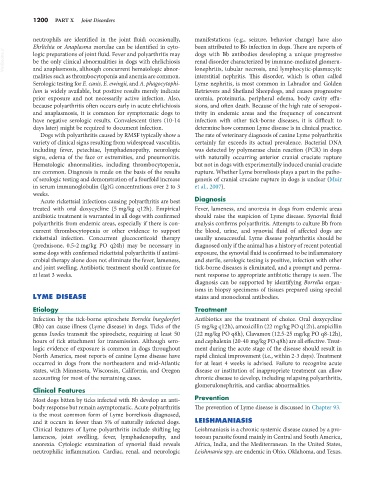Page 1228 - Small Animal Internal Medicine, 6th Edition
P. 1228
1200 PART X Joint Disorders
neutrophils are identified in the joint fluid; occasionally, manifestations (e.g., seizure, behavior change) have also
Ehrlichia or Anaplasma morulae can be identified in cyto- been attributed to Bb infection in dogs. There are reports of
VetBooks.ir logic preparations of joint fluid. Fever and polyarthritis may dogs with Bb antibodies developing a unique progressive
renal disorder characterized by immune-mediated glomeru-
be the only clinical abnormalities in dogs with ehrlichiosis
and anaplasmosis, although concurrent hematologic abnor-
interstitial nephritis. This disorder, which is often called
malities such as thrombocytopenia and anemia are common. lonephritis, tubular necrosis, and lymphocytic-plasmacytic
Serologic testing for E. canis, E. ewingii, and A. phagocytophi- Lyme nephritis, is most common in Labrador and Golden
lum is widely available, but positive results merely indicate Retrievers and Shetland Sheepdogs, and causes progressive
prior exposure and not necessarily active infection. Also, uremia, proteinuria, peripheral edema, body cavity effu-
because polyarthritis often occurs early in acute ehrlichiosis sions, and often death. Because of the high rate of seroposi-
and anaplasmosis, it is common for symptomatic dogs to tivity in endemic areas and the frequency of concurrent
have negative serologic results. Convalescent titers (10-14 infection with other tick-borne diseases, it is difficult to
days later) might be required to document infection. determine how common Lyme disease is in clinical practice.
Dogs with polyarthritis caused by RMSF typically show a The rate of veterinary diagnosis of canine Lyme polyarthritis
variety of clinical signs resulting from widespread vasculitis, certainly far exceeds its actual prevalence. Bacterial DNA
including fever, petechiae, lymphadenopathy, neurologic was detected by polymerase chain reaction (PCR) in dogs
signs, edema of the face or extremities, and pneumonitis. with naturally occurring anterior cranial cruciate rupture
Hematologic abnormalities, including thrombocytopenia, but not in dogs with experimentally induced cranial cruciate
are common. Diagnosis is made on the basis of the results rupture. Whether Lyme borreliosis plays a part in the patho-
of serologic testing and demonstration of a fourfold increase genesis of cranial cruciate rupture in dogs is unclear (Muir
in serum immunoglobulin (Ig)G concentrations over 2 to 3 et al., 2007).
weeks.
Acute rickettsial infections causing polyarthritis are best Diagnosis
treated with oral doxycycline (5 mg/kg q12h). Empirical Fever, lameness, and anorexia in dogs from endemic areas
antibiotic treatment is warranted in all dogs with confirmed should raise the suspicion of Lyme disease. Synovial fluid
polyarthritis from endemic areas, especially if there is con- analysis confirms polyarthritis. Attempts to culture Bb from
current thrombocytopenia or other evidence to support the blood, urine, and synovial fluid of affected dogs are
rickettsial infection. Concurrent glucocorticoid therapy usually unsuccessful. Lyme disease polyarthritis should be
(prednisone, 0.5-2 mg/kg PO q24h) may be necessary in diagnosed only if the animal has a history of recent potential
some dogs with confirmed rickettsial polyarthritis if antimi- exposure, the synovial fluid is confirmed to be inflammatory
crobial therapy alone does not eliminate the fever, lameness, and sterile, serologic testing is positive, infection with other
and joint swelling. Antibiotic treatment should continue for tick-borne diseases is eliminated, and a prompt and perma-
at least 3 weeks. nent response to appropriate antibiotic therapy is seen. The
diagnosis can be supported by identifying Borrelia organ-
isms in biopsy specimens of tissues prepared using special
LYME DISEASE stains and monoclonal antibodies.
Etiology Treatment
Infection by the tick-borne spirochete Borrelia burgdorferi Antibiotics are the treatment of choice. Oral doxycycline
(Bb) can cause illness (Lyme disease) in dogs. Ticks of the (5 mg/kg q12h), amoxicillin (22 mg/kg PO q12h), ampicillin
genus Ixodes transmit the spirochete, requiring at least 50 (22 mg/kg PO q8h), Clavamox (12.5-25 mg/kg PO q8-12h),
hours of tick attachment for transmission. Although sero- and cephalexin (20-40 mg/kg PO q8h) are all effective. Treat-
logic evidence of exposure is common in dogs throughout ment during the acute stage of the disease should result in
North America, most reports of canine Lyme disease have rapid clinical improvement (i.e., within 2-3 days). Treatment
occurred in dogs from the northeastern and mid-Atlantic for at least 4 weeks is advised. Failure to recognize acute
states, with Minnesota, Wisconsin, California, and Oregon disease or institution of inappropriate treatment can allow
accounting for most of the remaining cases. chronic disease to develop, including relapsing polyarthritis,
glomerulonephritis, and cardiac abnormalities.
Clinical Features
Most dogs bitten by ticks infected with Bb develop an anti- Prevention
body response but remain asymptomatic. Acute polyarthritis The prevention of Lyme disease is discussed in Chapter 93.
is the most common form of Lyme borreliosis diagnosed,
and it occurs in fewer than 5% of naturally infected dogs. LEISHMANIASIS
Clinical features of Lyme polyarthritis include shifting leg Leishmaniasis is a chronic systemic disease caused by a pro-
lameness, joint swelling, fever, lymphadenopathy, and tozoan parasite found mainly in Central and South America,
anorexia. Cytologic examination of synovial fluid reveals Africa, India, and the Mediterranean. In the United States,
neutrophilic inflammation. Cardiac, renal, and neurologic Leishmania spp. are endemic in Ohio, Oklahoma, and Texas.

